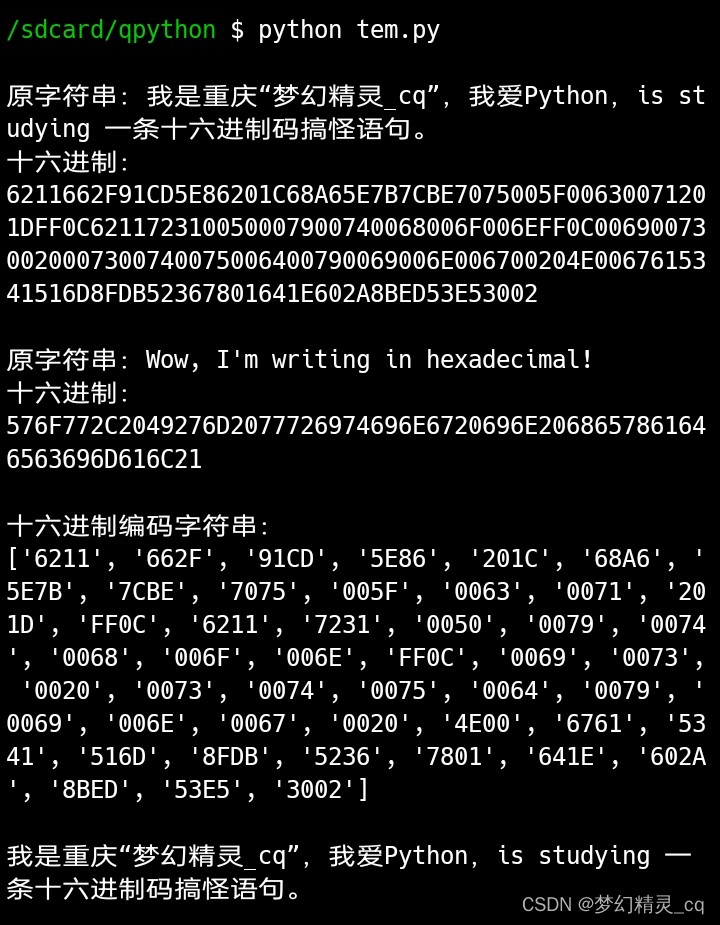Python 官網: python 前沿。可惜是英文原版。所以,我要練習英文閱讀。🧐🧐" rel="noopener noreferrer">https://www.python.org/
自學並不是什麼神秘的東西,一個人一輩子自學的時間總是比在學校學習的時間長,沒有老師的時候總是比有老師的時候多。
—— 華羅庚

單行裝逼代碼
print(''.join(chr(int(''.join(i), 16)) for i in zip(*[iter('576f772c2049276d2077726974696e6720696e2068657861646563696d616c21')]*2)))
Run這行代碼,會輸出下面那句話。我感覺好神奇!決定Study……
仔細“研究”、拆分後,發現是zip()對同一個迭代器作用,產生的Magic(魔法)。這又讓我想要對iter()“鑽研”了一番。
先看看iter()的“文檔”:
print(iter.__doc__)
iter(iterable) -> iterator
iter(callable, sentinel) -> iterator
Get an iterator from an object. In the first form, the argument must supply its own iterator, or be a sequence.
In the second form, the callable is called until it returns the sentinel.
“文檔”顯示:iter()有給定一個參數、給定兩個參數,兩種用法。
一、iter(iterable) -> iterator
當只給定一個參數時,參數必須是可迭代對象(iterable object),返回那個參數(iterable object)的iterator(迭代器)。換句話說,就是iter()賦予了iterable object能一個一個返回內容物(元素)的能力,就是讓iterable object具有了__next__()“魔法”方法。可以用內置函數next()實現,也可以用自身“新”得技能(next()方法)實現。iterable object參數可以是符合條件的“任意”Python對象。如:
/sdcard/qpython $ python
Python 3.10.2 (main, Mar 1 2022, 12:58:06) [Clang 12.0.8 (https://android.googlesource.com/toolchain/llvm-project c935d99d7 on linux
Type "help", "copyright", "credits" or "license" for more information.
>>> iter('ok')
<str_iterator object at 0x79d5ca4460>
>>> iter([3, 4])
<list_iterator object at 0x79d5c21c90>
>>> iter((6, 'c'))
<tuple_iterator object at 0x79d5c5aa70>
>>> iter({
3,9})
<set_iterator object at 0x79d5ca3a80>
>>> iter({
5: 6, 'ok': 'haha'})
<dict_keyiterator object at 0x79d5c36700>
>>>>
如您所見,各種對象返回的迭代器,都留著各自的“烙印”。字符串、列表、元組、集合、字典key,這Python五大基礎類型,都帶著各自的印記。這對“她”作為迭代器使用,毫無阻滯。下面就來煉煉:
>>> iter('ok').__next__()
'o'
>>> iter([3, 4]).__next__()
3
>>> iter((6, 'c')).__next__()
6
>>> iter(('c', 9)).__next__()
'c'
>>> iter({
3, 9}).__next__()
9
>>> d = iter({
5: 6, 'ok': 'haha'})
>>> d.__next__()
5
>>> d.__next__()
'ok'
>>>
一個一個迭代器,可以變著花樣使。
Python3.x內置函數zip()、map()返回的就是iterator。如:
>>> z = zip((4, 6), list('Good'))
>>> z
<zip object at 0x78cffa1380>
>>> z.__next__()
(4, 'G')
>>> z.__next__()
(6, 'o')
>>> z.__next__()
Traceback (most recent call last):
File "<stdin>", line 1, in <module>
StopIteration
>>> m = map(str, range(6, 9))
>>> m
<map object at 0x78cff99de0>
>>> next(m, 'The end.')
'6'
>>> next(m, 'The end.')
'7'
>>> next(m, 'The end.')
'8'
>>> next(m, 'The end.')
'The end.'
>>>
由前面“操作”可以看出,zip object、map object她就是iterator,她們有__next__()方法,內置函數next()也可以調用。
>>> next(zip((4,), ['d']))
(4, 'd')
>>> map(int, list('456')).__next__()
4
iter(object)配合zip()的“特殊”用法
iter()借助zip()和*星號“聯眾”之力,可以實現用簡潔的代碼完成序列定長選取。例:
為簡化例子,先定義了個函數mychoice(iterator, num)。
>>> def mychoice(iterator, num):
... ''' iterator -> 迭代器對象 ... num -> int,連續取值數量 '''
... return zip(*[iterator]*num)
...
>>> print(*mychoice(iter(range(9)), 2))
(0, 1) (2, 3) (4, 5) (6, 7)
>>> print(*mychoice(iter('Chongqing'), 3))
('C', 'h', 'o') ('n', 'g', 'q') ('i', 'n', 'g')
>>>
神不神奇,驚不驚喜。這,就是本筆記開篇提到的“裝逼代碼”的“奇妙”用法。您也許已經發現,由於zip()的特性,不能完全匹配成組的序列元素,被捨棄。比如還原十六進制編碼的字符,四位或者兩位都是沒有余數的,所以對“實際”的應用,幾乎沒有影響。這,是如何實現的哩?我想是基於迭代器“只可以讀取一次”的特性,在iter()官方文檔沒有找到相關說明。因為我在這裡zip()的參數,都是同一個迭代器,重復幾次迭代器就是實現連續取幾個序列元素。
上面的return 語句,也可以寫成
return zip(iterator, ierator, ...) # 想連續取幾個序列元素就重復幾次。
舉個粟子:
>>>
>>> iterator = iter('I love you.')
>>> tem = iterator
>>> print(*zip(tem, tem, tem))
('I', ' ', 'l') ('o', 'v', 'e') (' ', 'y', 'o')
>>>
對同一個迭代器,在zip()參數中重復三次,就完成了連續三個字符的選取。
利用這一“特性”,可以“異想天開”的做些事情。例如:把十六進制字符編碼還原成“本來的樣子”。
s = '我是重慶“夢幻精靈_cq”,我愛Python,is studying 一條十六進制碼搞怪語句。'
en = "Wow, I'm writing in hexadecimal!"
hex_s = '576F772C2049276D2077726974696E6720696E2068657861646563696D616C21'
def to_hex(s, num=2):
''' 將字符轉換成十六進制編碼,\n字符含中文num=4,\n默認純英文。 '''
return ''.join(map(lambda x: hex(ord(x))[2:].upper().zfill(num), s)) # 轉換字符編碼並去除十六進制標識字符用設置位數存儲,不足位補“0”。無縫拼接字符,返回字符串。
if __name__== '__main__':
print(f"\n原字符串:{
s}\n十六進制:\n{
to_hex(s, 4)}") # 用四位十六進制字符保存字符編碼。
print(f"\n原字符串:{
en}\n十六進制:\n{
to_hex(en)}") # 用to_hex()默認參數轉換英文字符成2位十六進制ASCII編碼。
b = zip(*[iter(to_hex(s, 4))]*4) # 轉換字符成十六進制字符編碼。
print(f"\n十六進制編碼字符串:\n{
[''.join(i) for i in b]}\n") # 打印十六進制字符編碼字符串。
b = zip(*[iter(to_hex(s, 4))]*4) # 轉換字符成十六進制字符編碼。
for i in b: # 遍歷還原字符。
print(chr(int(''.join(i), 16)), end="")
輸出截屏圖片
在對迭代器變量b的操作中,為什麼會對其兩次賦值。因為b在打印十六進制字符編碼列表時,已讀取b所以再對b操作得先賦值。(iterator只可以讀取一次。)
也可見只用一條復合語句完成還原,或者轉換 -> 還原整個過程。不過,“較長”的復合語句“生澀難讀”,除了“裝逼”,少用為宜。
print(f"\n\n{
''.join([chr(int(''.join(i), 16)) for i in zip(*[iter(hex_s)]*2)])}")
print(f"\n{
''.join(map(lambda x: chr(int(''.join(x),16)), zip(*[iter(to_hex(s,4))]*4)))}\n")
輸出截屏圖片
二、iter(iterable, sentinel) -> iterator
如果給出第二參數sentinel,第一個參數必須是可調用對象(不帶參數的函數或者類方法,且每次調用會返回一個值),循環調用第一個參數,直到==第二參數(sentinel的值)。正如sentinel的釋義一樣,就是——“哨兵”——到此為止。不返回sentinel的值。如:
or more information.
>>> lis = range(9)
>>> iterator = iter(lis)
>>> tem = iter(iterator.__next__, 7)
>>> tem
<callable_iterator object at 0x78d0163940>
>>> print(*tem)
0 1 2 3 4 5 6
>>>
>>> iterator = iter('I am Dream elf, I live in Chongqing.')
>>> print(iter(iterator.__next__, ','))
<callable_iterator object at 0x78d01638b0>
>>> print(*iter(iterator.__next__, ','))
I a m D r e a m e l f
當第二參數sentinel是7時,就輸出她前面的0~6,不輸出7;當sentinel是“,”,就輸出前半句字符串,不帶輸出“,”。
iter()官方文檔:
文檔鏈接https://docs.python.org/3/library/functions.html#iter
文檔內容,
iter(object[, sentinel])
Return an iterator object. The first argument(參數) is interpreted very differently depending on the presence of the second argument. Without a second argument, object must be a collection object which supports the iterable protocol (the iter() method), or it must support the sequence protocol (the getitem() method with integer arguments starting at 0). If it does not support either of those protocols, TypeError is raised. If the second argument, sentinel, is given, then object must be a callable object. The iterator created in this case will call object with no arguments for each call to its next() method; if the value returned is equal to sentinel, StopIteration will be raised, otherwise the value will be returned.
See also Iterator Types.
One useful application of the second form of iter() is to build a block-reader. For example, reading fixed-width blocks from a binary database file until the end of file is reached:
from functools import partial
with open(‘mydata.db’, ‘rb’) as f:
for block in iter(partial(f.read, 64), b’'):
process_block(block)
參考CSDN博文:

來源:老齊教室
全棧領域優質創作者——寒佬(還是國內某高校學生)好文:《非技術文—關於英語和如何正確的提問》,“英語”和“會提問”是學習的兩大利器。
【8大編程語言的適用領域】先別著急選語言學編程,先看它們能干嘛
靠譜程序員的好習慣